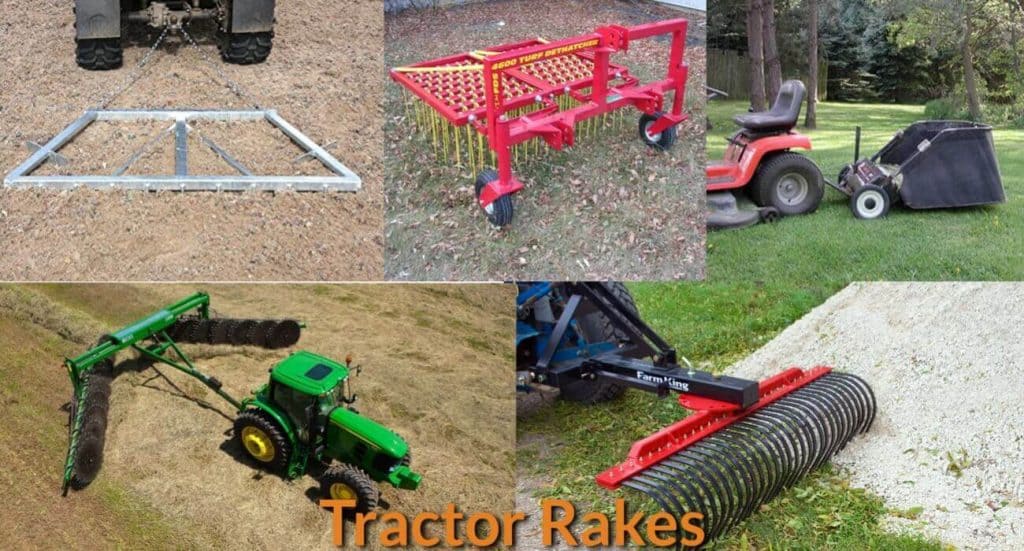June 13, 2021

The tractor rake is one of the best implements for landscape management. Rake attachments are the types of implements that attached to the back of the tractors via the 3-point hitch. Typically the rake is 4 feet wide at the minimum for the sub-compact lawn tractors and can be longer up to 10 feet for the compact and big tractors. However, the hay rake is much wider than most types of rakes.
What is Tractor Rake?
Lawn tractors are designed for pulling a variety of attachments. It can pull scrapers, rakes, and dump carts. Rake attachments—although like the rake attachments for riding lawnmowers—are basically different, because they are meant for heavy-duty clearing tasks. Most landscape rakes are around four feet in width or more, depending on the size, brand, and horsepower of the landscape rake and the tractor. The 3-point hitch or sleeve enables the rake to be attached to the tractor.
Tractor rakes (according to their working parts) are usually categorized into two different classes, namely: rakes with spring teeth and finger-wheel rakes. However, tractor rakes may also be classified under one of these four types:
1) Transverse Tractor Rakes/ Hay Rakes
Transverse tractor rakes can arrange the hay into piles that are perpendicular to the tractor’s directions. The design of a transverse tractor rake may vary according to which company manufactures them, and transverse tractors usually differ in width. Transverse tractor rakes, for example, that are made in USSR have widely-used broad-swath rakes of the GP-14 models with 14-m work span.
Tractor rakes are made of three hinge-jointed sections with their decurved spring teeth. These three hinge-jointed sections also have also automatic parts, support wheels, and mechanism for lifting the teeth. As the unit operates, the teeth rake the hay quickly together. Once the hay is formed into a box shape by the teeth of the rake, the operator then engages the mechanism that meticulously lifts the teeth. Then, the cleaning rods quickly push the hay bundles towards the ground. Afterward, the teeth move back automatically to their original position.
If you use the transverse tractor rake to clear a small parcel of land, the middle section of the tractor’s rake pile together the hay. This middle section is 6-meter wide. Transverse tractor rake gathers the hay into swaths and can rake them into piles, and eventually, turn the piles. The transverse tractor’s rake is usually made of two drum sections held up by independent wheels. The rake likewise is oriented at 45° angle towards the direction of the motion of the machine.
The rotation of the drums and spring teeth originates from the drive wheels. As the machine moves, the drums also move forward the hay; then, the drums move the hay to the side, leading to the formation of loose, doubled-over bale. The two sections of the rake are used in raking and turning hay. When turning the bales, however, the rake only uses one of its sections.
2) Landscape Rake
The landscape rake is also called “root rake” or “rock rake.” This rake is used to gather stones, stubborn muscle roots, and break dirt clods up. The main feature of this rake is its strong metal tines that are spaced an inch apart from each other. This setting enables the rake to capture and gather more trash, rocks, and debris. You can also use this rake to level the soil and prepare seed beds. Moreover, it can also be used for spreading topsoil materials. This type of rake also often had a lever for quick lowering and easy raising of the rake. Thus, the height of this rake is very much adjustable.
For a tractor to be efficient in clearing debris, a landscape rake is usually appended to it. This rake is more often interchangeably called “york rake” or “rock rake.” The main features of a landscape rake are the many curved C-tines that are often pulled and sometimes pushed just behind the tractor. The landscape rake features a spring-like action to keep the tines firmly grounded without necessarily messing up the field nor tearing too deep into the ground. There are many uses for a landscape rake. Aside from clearing debris and piling up hay, it can also clear roots, rocks, sand, and other debris. It can also angle for windrowing. On the other hand, when it is moving in the reverse direction, it can push debris back toward structures or property lines.
Landscape rakes more often are designed by manufacturers, specifically, to fit the tractor model readily, and their prices usually range between several hundred dollars and several thousand dollars.
3) Dethatching Rake/ Tractor Dethatcher Rake
This type of rake does not collect material unlike that of the landscape rake. The dethatching rake is also called “vertical mower.” It is mainly designed for cutting through mats of old clippings of grass and decaying stems and roots that are found in the soil just around the grass stems. Thatch usually clings stubbornly to the soil, and they must be forcibly sliced away or yanked. This type of rake can also double up like a lawn aerator.
4) Mulching Sweeper Rake
The mulching sweeper rake is usually attached to the mowing deck and rear hitch of the tractor. It enables its user to mow small sticks, leaves, and other vegetative detritus into small manageable pieces. These chopped materials are then flung out to the side discharge part of the mower. Afterward, they are then sucked up by a powerful vacuum attachment and eventually deposited into a particular container attached to the tractor’s back.
This type of rakes can readily pick up almost all types of debris, leaves, and other trash. Moreover, you can easily tilt the container mechanically or manually when dumping the debris. With this implement, you can easily dispose of trash and composting materials without necessarily tiring yourself completely. Lastly, with its use, you can make your lawn looking well-groomed and fresh without necessarily breaking your back.
